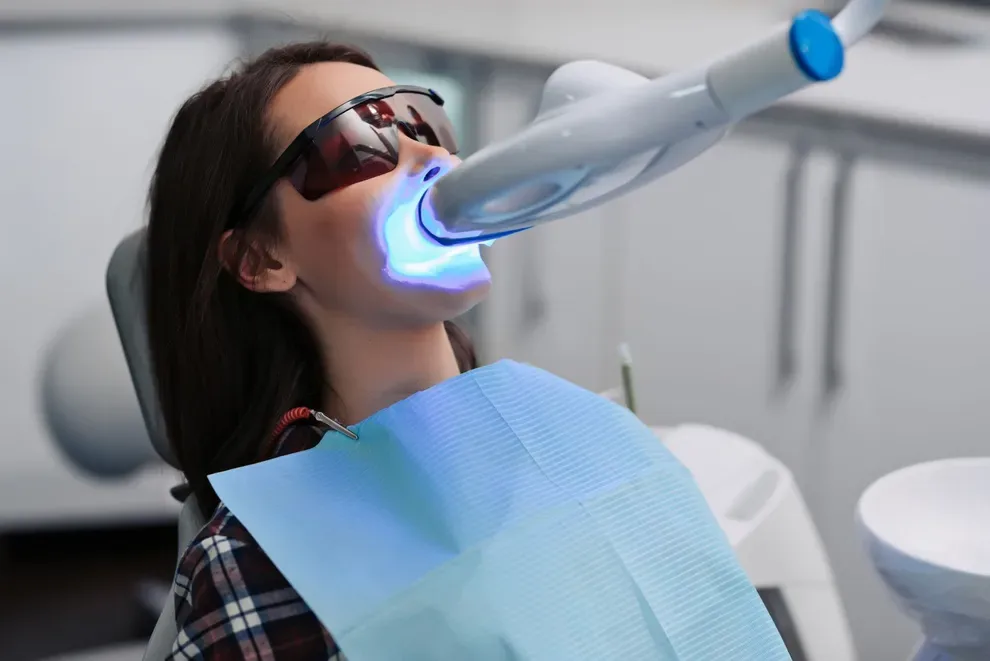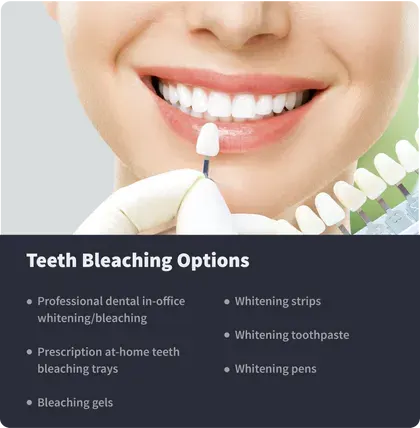What Is Teeth Bleaching? Does It Work?

Table of Contents
- Bleaching vs Whitening
- Teeth Bleaching Variations
- Teeth Bleaching Success
- Maintaining Teeth Whitening
- Potential Pitfalls
- References
Teeth bleaching, also called teeth whitening, is the process of using a tooth bleaching agent (usually hydrogen peroxide or carbamide peroxide) to break down stains and help teeth appear whiter and brighter.
Since their introduction to the market, the demand for tooth whitening products has grown substantially. For people who are looking to improve their smile, brighter and whiter teeth are a top priority.
A survey performed by the American Association of Orthodontists reported that almost 90 percent of patients wanted a tooth whitening service. The growing popularity of virtual meetings and social media has also caused more people to focus on dental self-care.
Today, there are more teeth bleaching options on the market than ever before, from in-office dentist treatments to costly tooth bleaching kits to value whitening toothpastes.
While tooth bleaching isn’t for everyone, and the results of some products can be subtle at best, many people can find a whitening product that will help boost their smile and confidence.
The Difference Between Bleaching & Whitening
Most of the time, teeth whitening and teeth bleaching are considered to be the same thing. There is a subtle difference, however.
With whitening, the goal is to restore the natural color of your teeth. With bleaching, your teeth are whitened beyond their natural color.
In general, the terms teeth bleaching and teeth whitening are used interchangeably. But in order to be considered bleaching, an actual bleaching agent like peroxide must be used.
Forms of Teeth Bleaching
There are a multitude of teeth bleaching products and methods on the market. It can feel overwhelming to consider all the options.

In 2019, nearly 40 million people in the United States used a tooth whitening product. Teeth bleaching is either done under the direction of a dental professional or with over-the-counter products.
Options for teeth bleaching can include:
Professional dental in-office whitening/bleaching.
Prescription at-home teeth bleaching trays.
Bleaching gels.
Whitening strips.
Whitening toothpaste.
Whitening pens.
Bleaching that is done by your dentist or through a prescription is going to contain a higher concentration of hydrogen peroxide or carbamide peroxide (the bleaching agents). As a result, it is more likely to work faster and with fewer treatments than over-the-counter applications and products that are used at home. The results from these doctor-monitored treatments tend to be more dramatic.
Professional bleaching techniques typically work more quickly and last longer than over-the-counter products.
Professional Bleaching Treatments
Teeth bleaching done at the dentist office can use a variety of applications, but they essentially place a high concentration of hydrogen peroxide or carbamide peroxide on your teeth and then use a specialized light or laser to break down the stains.
A professional tooth whitening procedure typically takes about an hour and uses a bleach concentration of 25 to 40 percent.
In-office teeth bleaching procedures are often followed up with custom-fitted trays that you can take home to reapply the bleach in future applications.
You can also get prescription bleaching trays to use at home under the direction of your dentist. These will often have a lower concentration of bleach than the in-office procedure uses but a higher concentration than drugstore options.
Over-the-Counter Options
Most over-the-counter teeth bleaching or whitening options contain a much lower concentration of hydrogen peroxide (or carbamide peroxide). On average, they only have between 5 and 6 percent of the bleaching agent in them.
Whitening Toothpastes
Whitening toothpastes use mostly abrasive materials to remove stains, but many also contain some of the bleaching agent hydrogen peroxide as well.
Gels & Whitening Pens
Paint-on applications use a low concentration of hydrogen peroxide or carbamide peroxide, but your saliva can often break most of this down before it can be extremely effective.
Strips
Teeth whitening strips are placed on your teeth for a specific amount of time each day, allowing the bleaching agent to have direct contact with your teeth. They also have a low concentration of hydrogen peroxide compared to prescription options, however.
Tooth Whitening Kits
Over-the-counter kits often contain trays to use daily to whiten your teeth, but they are not custom-fit to your teeth. The bleaching agent levels are much lower than dentist-provided, at-home bleaching kits.
Gels, at-home trays, whitening strips, toothpastes, and teeth whitening pens can all lighten your teeth a little. These over-the-counter products will generally take much longer, require more applications, and be less effective than procedures that are prescribed and performed by dentists.
Success of Teeth Bleaching
Teeth bleaching, especially under the direction of a dentist, can be extraordinarily successful and effective. The efficacy of teeth bleaching does depend on several factors, such as:
What caused the staining in the first place and the type of stain.
Your age.
Treatment time and frequency.
Concentration of the bleaching agent used.
Teeth whitening is reported to be effective and safe when done as directed. The best route is involving your dentist in the process. While professional options are more expensive than do-it-yourself options, they get better results. As with most things, you get what you pay for.
How to Keep your Teeth White after Bleaching
After investing in a teeth-bleaching procedure or at-home whitening product, the last thing you want to do is stain or discolor your teeth again. While it may be difficult to keep your teeth as pristine as they look and feel after a quality bleaching treatment, there are steps you can take to maintain your pearly whites.
Keep Up On your Dental Hygiene Routine
The most important thing you can do to keep your teeth looking great is to take care of them with a diligent daily routine.
By keeping up with your oral care, you’ll fight off bacteria and plaque that can dull your smile and result in stains and unsightly tartar. Reducing plaque and bacteria doesn’t change the color of your actual teeth, but it removes the layers of buildup that can accumulate on the surface layer of teeth and on the surrounding gum line, allowing your teeth to appear brighter and cleaner.
A good oral care regimen will also promote oral health (which relates to your overall health) and prevent tooth decay and gum disease — two main causes of oral and dental problems.
An effective oral hygiene routine should include the following steps:
Brush teeth twice daily. Using a soft-bristled brush can reduce tooth damage. Be sure your toothpaste includes cavity-fighting fluoride.Tilt the toothbrush at a 45-degree angle to help you access the gum line, where plaque and bacteria like to hide. Use short, continuous strokes.
Floss once a day. To remove the particles that get in between teeth and fight bacteria buildup, flossing is a must. Today, there are many flossing options available, including flavored and whitening floss. Flossing picks and interdental brushes can also make flossing easier for those with physical limitations.Whatever tool you’re using, carefully clean between each tooth. Don’t reuse floss, picks, or interdental brushes.
Brush your tongue with a tooth scraper or your toothbrush. Many people ignore their tongue during toothbrushing, but it can be a gathering spot for bacteria.
Use an antibacterial mouthwash each day. A quality mouthwash will help reduce plaque buildup. Choose an alcohol-free one to prevent dry mouth.
Keep your dentist appointments. Regular checkups and cleaning will keep stain-causing plaque buildup at bay and ensure any problems are addressed early.
Other Tips to Keep your Teeth Bright
There are other good habits that can help keep your teeth whiter, including these:
Quit smoking. If you’re a cigarette smoker, quitting the habit will result in a multitude of health and wellness benefits, including whiter, healthier teeth.Thinking about quitting? You can check out the many resources available on Smokefree.gov here.
Quit or minimize stain-causing beverages like coffee, soda, and wine. Continuously drinking these tooth-staining drinks can make it difficult to keep teeth whiter.
Consider using a reusable straw for stain-causing beverages. This will limit the contact the beverages have with your teeth.
Drink more water, especially after eating or drinking something that can cause stains. Water will help “rinse” the teeth.
Brush after stain-creating meals or drinks. But be sure to use a soft toothbrush and be gentle to avoid irritating gums or causing tooth damage. Also, wait at least 30 minutes after eating or drinking something acidic before brushing (to prevent spreading the acidity around on teeth).
Invest in whitening daily dental care products. There are many affordable whitening toothpastes and mouthwashes to help maintain your brighter smile after a bleaching treatment.
Eat a balanced diet. Avoiding sugary and acidic snacks will help in preventing decay and gum-irritating inflammation. Plus, eating nutrient-rich whole foods aids in promoting strong bones and teeth.
Certain foods can even help with plaque and bacteria. Yogurt, for example, not only contains fortifying calcium, but it also contains probiotics that can prevent gum disease, tooth decay, and bad breath.
Potential Pitfalls of Tooth Bleaching
Teeth bleaching and whitening can cause your gums to become irritated and your teeth to be extra sensitive, the ADA warns. Tooth sensitivity and gingival irritation are typically short-lived. They will usually go away a few days after the treatment is finished.
Bleaching your teeth can cause some breakdown in your healthy enamel, and it is not effective on tooth restorations. A few years after a bleaching procedure, your teeth will start to become discolored again and require additional treatments.
The more concentrated the bleaching agent, the higher the potential risks. Talk to your dentist about the best form of teeth bleaching for your smile.
